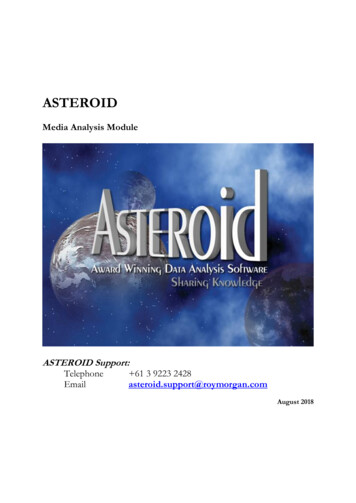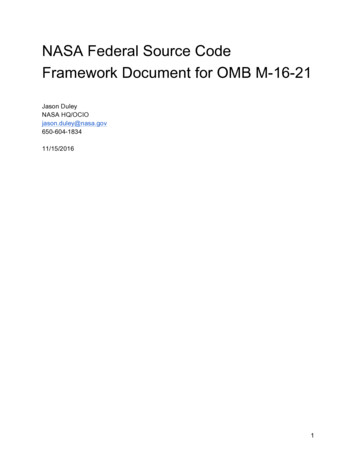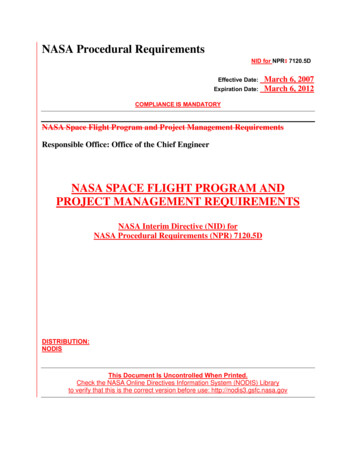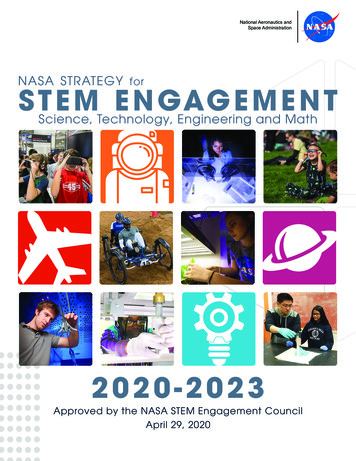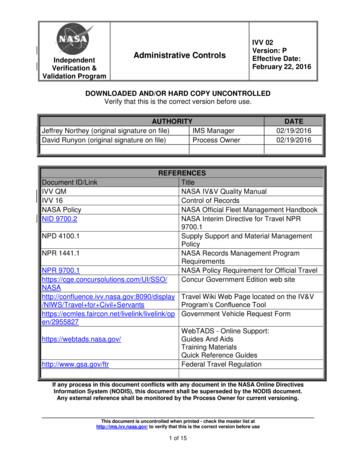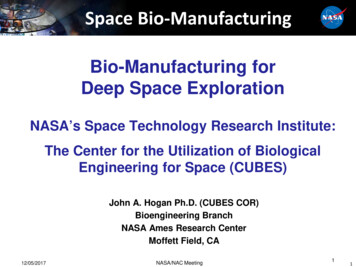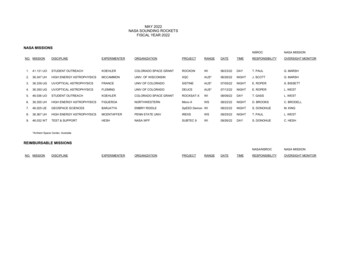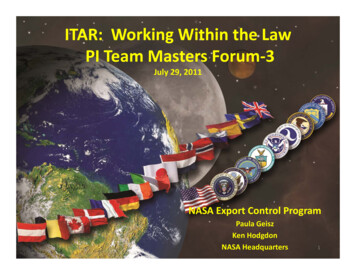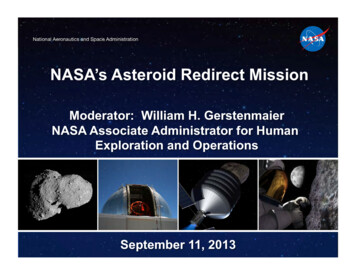
Transcription
NASA’s Asteroid Redirect MissionModerator: William H. GerstenmaierNASA Associate Administrator for HumanExploration and OperationsSeptember 11, 2013
Overall Mission Consists of Three ent:Asteroid CrewedExplorationSegment:Ground and spacebased NEA targetdetection,characterizationand selectionSolar electricpropulsion (SEP)based roboticasteroid redirect totrans-lunar spaceOrion and SLS basedcrewed rendezvousand sampling missionto the relocatedasteroid2
Asteroid Redirect Mission:Observation CampaignPaul Chodas, NASA NEO Program Office
NASA’s NEO Search ProgramsCatalina SkySurveyPan-STARRSLINEARU of AZArizona & AustraliaU of HIHaleakala, MauiMIT/LL 60% 30%Soccoro, NM 3% NEO Near Earth Object (99% are NEAs, Near-Earth Asteroids) Since 1998, NASA’s NEO Observation Program has led the international NEOdiscovery and characterization effort. 95% of 1-km and larger NEAs have been discovered. Total number NEAs now known: 10,090; increasing at 1,000 per year.4
Discovery & Characterization ProcessesDiscovery,Orbit Determination,Rough SizeEstimationDiscovery &Initial AstrometryExistingExistingprocess thatprovides orbitautomatedestimates andprocessesmagnitudeMinor PlanetCenterNEO otometry,Light Curves,ColorsOrbit, area/massratio, size, rot. rate,spectral typeScreening forObjects ofInterestFollow-upAstrometryVisible & IRSpectroscopy,IR radiometryRadarSpectral type, size& mass, possiblycompositionPrecise Orbit,size & rotationrate5
ARM Candidate Targets Requirements: Earth-like orbit about the Sun. Close Earth approach in the early 2020s. Size constrained to 7 to 10 meters ( 20 to 30 feet). Slow to moderate spin rate (less than 2 rpm). Estimated number of suitable candidates: 10,000, but hard to detect. 14 have been discovered so far by current surveys (2-3 per year), but sizes ofmost of these were not accurately characterized when discovered. Sizes of 2 of the candidates couldbe characterized within a year,and another in 2016. Rapid response will be used whenpossible for future candidates tocharacterize size and spin rateimmediately after discovery.6
Enhancements for ARM Candidate Discovery NEOs on DARPA Space Surveillance Telescope Built for DoD Space Situational Awareness. Testing of NEO detection capability: Sep 2013. Enhancing Pan-STARRS 1, Completing Pan-STARRS 2 Increase search time to 100% on PS1: Early 2014. Complete PS2 (improved copy of PS1): Late 2014. Accelerated Completion of new survey ATLAS Extremely wide field, covering entire night sky everynight, but not as deeply. Detects NEAs close to Earth. Completion: Early 2015. With these and other enhancements, the ARMcandidate discovery rate should increase to at least 5per year. These enhancements will also increase capability forfinding hazardous asteroids in general.7
Radar Observations of NEAsBennu (OSIRIS-ReX Target)Goldstone 70 m2012 XB112, size 2 mArecibo 305 m 10-m-class NEAs observable out to 5 lunardistances; 80% of the ARM candidatesshould be radar observable once detected. Range 70-80 NEOs are observed every year. Radar observations can provide: Size and shape to within 2 meters. High precision orbit data. Spin rate, surface density and roughness.Doppler frequency 88
NEO Characterization EnhancementsRadar (Goldstone and Arecibo) Increase time for NEO observations. Streamline Rapid Responsecapabilities.Goldstone RadarArecibo ObservatoryNASA InfraRed Telescope Facility (IRTF) Increase On-call for Rapid Response. Improve Instrumentation for Spectroscopyand Thermal Signatures.NEOWISEReactivate NEOWISE (in work) 3 year warm phase dedicated toNEO Search/Characterization datacollection.JPLSun-synch LEO9
Asteroid Redirect Robotic Mission(ARRM)Contributing NASA Centers:JPL, GRC, JSC, LaRC, MSFC, KSC, GSFCBrian Muirhead, ARRM Study Lead
ARRM Architecture NASA has been performing architecturelevel trade studies to establish the feasibilityof missions to small and/or large near Earthasteroids, including:– Demonstrate high-power, extensibleSEP– Returning an asteroid (10m, 1000tclass) or a part of an asteroid (3 m, 20tclass) to a lunar DRO for crewexploration– Conducting a planetary defensedemonstration at the asteroid11
Small Asteroid Mission Concept Rendezvous with small ( 10m meandia.) near Earth asteroid (NEA)– Examine opportunities and proofof concept– Capture 1000t spinning NEAand despin– Maneuver to stable, crewaccessible lunar orbit (e.g. DRO) Candidate target is 2009 BD,which is 500t– Other targets to be discoveredand characterized by radar– Primary constraints are target Vinfinity, size, mass, spin rate, andlaunch date and launch vehicle40-kW SEPvehicleand CaptureSystem6.5-m dia. 340-t“Levitated Mass”12
Small Asteroid Mission Mission Design5) Asteroid Operations: rendezvous,characterize, deploy capture mechanism,capture, and despin (60 days)Asteroid Orbit6) SEP redirectto Lunar orbit4) SEP low-thrustcruise to Asteroid2) Separation &S/A Deploy3) LunarGravityAssist(if needed)7) LunarGravityAssist2a) Spiral out toMoon if Atlas V 551Initial Earth Orbit (spiral only)2) Separation & S/A Deploy1)Launch direct to LGA (SLS, or FalconHeavy) or to Earth Orbit (Atlas V 551)Earth8) SEP transferto safe DRO9) Orionrendezvous &crew operations
Large Asteroid Mission Concept Rendezvous with a large ( 100 m)NEA– Collect 2-4 m boulder ( 10-70t)– Perform planetary defensedemonstration(s) & track todetermine effect– Return boulder to stable, crewaccessible lunar orbit (e.g. DRO) Candidate target Itokawa, could return18t boulder in August 2023– Other targets to be characterizedby radar or direct observation (e.g.Bennu by OSIRIS-Rex & 1009JU3 by Hayabusa 2)– Primary constraints are NEA Vinfinity, launch date and launchvehicle, and size, mass, andretrievability of bouldersDepiction of Non-ContactPlanetary Defense DemoBoulders on Itokawa14
ARRM Flight System Key Driving Objectives:– Demonstrate high power, 40 kW,SEP technology in deep space– Cost driven paradigm Balance risk across major elements– Uncertainties in asteroid/bouldercharacteristics– SEP technology development– Proximity operations and captureapproach Modular design– SEP: 4 Hall thrusters, 10t of Xe– High heritage avionics– Capture Adapter15
ARRM Versatility and Extensibility Studies to date have identified a suite oftechnically and programmatically feasiblecapabilities that can be integrated in differentways to enable a broad class of missions Asteroid Redirect Missions Planetary Defense demonstrations Science Missions Exploration Missions Mission provides key technologies— SEP,mission design, prox-ops—that areaffordable stepping stones to missionsrequiring large payloads to the lunar surfaceand/or Mars16
Space Technology &NASA’s Asteroid Redirect MissionDr. James ReutherDeputy Associate Administrator for Programs,Space Technology Mission Directorate
High-Powered Solar Electric PropulsionSolar ArraysThruster and PowerProcessing Unit (PPU)Propellant Feed Systemand Storage Tanks18
High-powered SEP Enables Multiple ApplicationsDeep SpaceHumanExplorationSatellite ServicingPayload olar ElectricPropulsionOrbitalDebrisRemovalSpace ScienceMissionsOGAMissions19
Advancing Solar Electric Propulsion TechnologyDeep Space 11998Dawn2007AEHF e MissionSatellite orbitestablished with HallThrusters2.5 kW powersystem2kW EP system10 kW power system2.5kW EP system 16kW-class power 4.5kW-class EPAsteroid RedirectMissionFar-term ExplorationMissions circa 2030ʼsRobotic Mission toCrewed mission beyondRedirect Asteroid toEarth spaceTrans-Lunar Orbit50kW-class powersystem10 kW-class EP350kW-class powersystem300kW-class EP20
Crewed Mission SegmentSteve Stich – Deputy Director, JSC Engineering
Reference Trajectory: Earliest Mission for 2009BD OutboundFlight Day 1 – Launch/Trans LunarInjectionFlight Day 1-7 – Outbound TransLunar CruiseFlight Day 7 – Lunar Gravity AssistFlight Day 7-9 – Lunar to DRO Cruise Joint OperationsFlight Day 9-10 – RendezvousFlight Day 11 – EVA #1Flight Day 12 – EVA #2 PrepFlight Day 13 – EVA #2Flight Day 14 – Departure PrepFlight Day 15 – Departure InboundFlight Day 15 – 20 – DRO to LunarCruiseFlight Day 20 – Lunar Gravity AssistFlight Day 20-26 – Inbound TransLunar CruiseFlight Day 26 – Earth Entry andRecoveryEarthOutbound Flight Time9 daysReturn Flight Time11 daysLunar GravityAssistsMoonDistant Retrograde Orbit (DRO)Mission Duration and timing of specific events will varyslightly based on launch date22
Mission Kit Concept Enables AffordableCrewed MissionTools & Translation AidsSample Container KitEVA Communications KitRepress Kit23
Mission Kit Concept Enables AffordableCrewed Mission Docking System- LeveragesInternational Space Stationdevelopment of International DockingSystem Standard Relative Navigation Sensor Kit basedon Space Shuttle Flight Tested OrionSensorsRelative Navigation Sensor KitRobotic Spacecraft PassiveHalf of Docking MechanismOrionActive Half of DockingMechanism (extended)24
Extravehicular Activity (EVA) Details Orion-based EVA with two Crewmembers Two EVAs One Contingency Short Duration ( 4 hours)25
Accommodations for Crewed MissionExtra Vehicular Activity (EVA) Translation Booms Translation Booms for Asteroid EVAEVA Tether Points Hand-over-handtranslation Temporary toolrestraint Management ofloose fabric foldsPre-positioned EVA Tool Box Tool box stores 85 kg toolsEVA Translation AttachHardware Circumference of MissionModule at base ofCapture System and ARVOrion InterfaceHand Rails Translation path tocapture bag Ring of hand rails nearcapture bag26
First Steps to Mars and Other idRedirectMissionLongStay InDeepSpaceHumansto MarsOrbitHumans toSurface,Short StayHumans toSurface,Long StayIn Situ Resource Utilization & SurfacePowerXSurface HabitatXEntry Descent Landing, Human LanderXXAero-captureXXXAdvanced Cryogenic Upper StageXXXSolar Electric Propulsion for CargoXXXXXDeep Space Guidance Navigation andControlXXXXXCrew Operations beyond LEO (Orion)XXXXXCrew Return from Beyond LEO - HighSpeed Entry (Orion)XXXXXHeavy Lift Beyond LEO (SLS)XXXXXDeep Space Habitat*XXXXHigh Reliability Life Support*XXXXAutonomous Assembly*XXXX27
Asteroid Redirect Mission builds upon Orion/SLSto enable Global Exploration RoadmapAsteroid ExploitationMissionsLunar SurfaceMissionsDeep SpaceMissions28
Asteroid Initiative Ideas Synthesis WorkshopSeptember 30 – October 2, Houston, TX NASA received over 400 ideas from the Asteroid Initiative RFI. 96 ideas were selected for discussion at the workshop to help NASAformulate plans for the Asteroid Initiative. Everyone is welcome to participate virtually:www.nasa.gov/asteroidinitiative29
AEHF Recovery 2010 Satellite orbit established with Hall Thrusters 16kW-class power 4.5kW-class EP Asteroid Redirect Mission . Robotic Mission to Redirect Asteroid to Trans-Lunar Orbit 50kW-class power system 10 kW-class EP Far-term Exploration Missions circa 2030. ʼs Crewed mission beyond Earth space . 350kW-class power system 300kW-class EP 20
